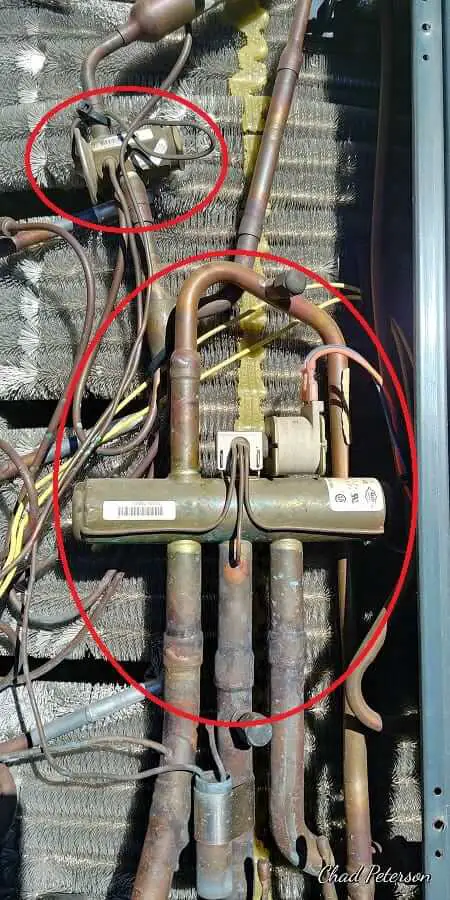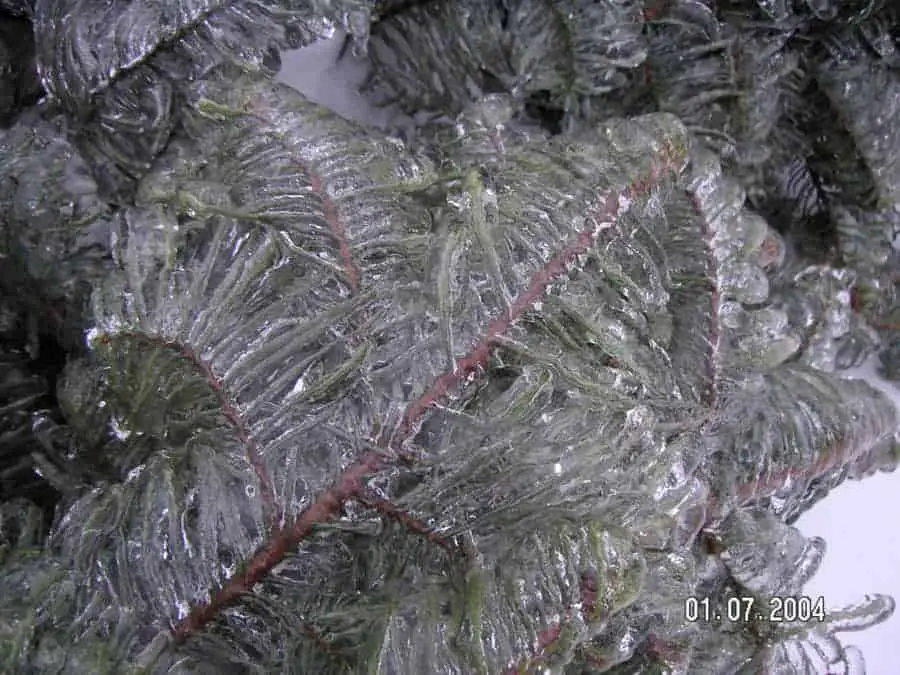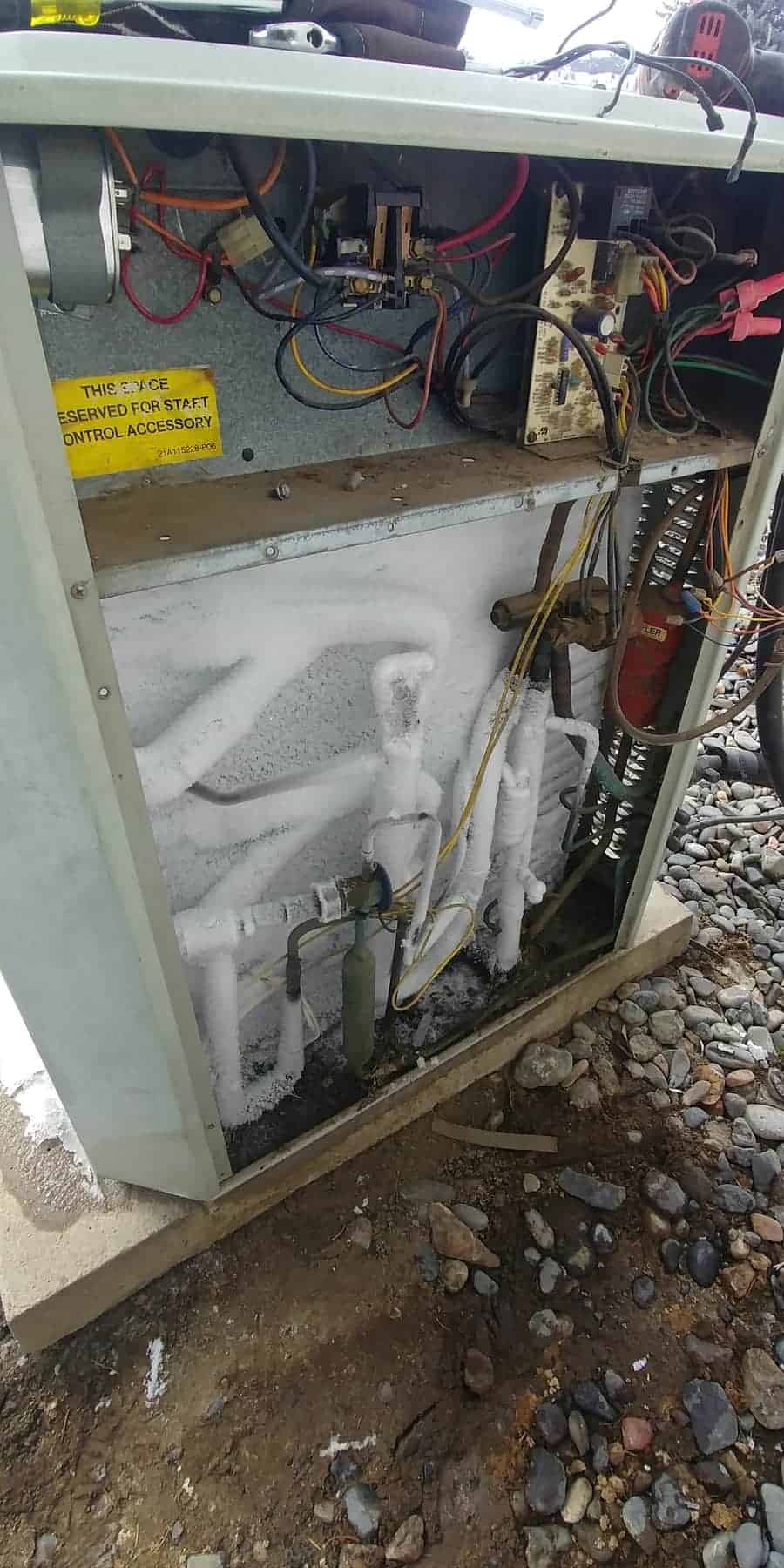You can switch your heat pump into the cool mode. Assuming your heat pump contains the correct amount of refrigerant (Freon).
If the temperature inside your home is near or above 70 degrees you can switch your thermostat to the cool mode, set the thermostat below the temp in your home.
When the heat pump comes on, it should melt the ice slowly.
If the running time in the cool mode seems too long and does not satisfactorily melt the ice, you may need to use more extreme methods, such as pouring hot water on a frozen heat pump. Even tap water from the hose will do some melting, assuming your hoses aren’t all iced up inside.
It’s important to differentiate between how to defrost a heat pump in winter and a heat pump freezing up in summer. In summer, the indoor coil or the coil in the furnace would be the location where the icing would occur.
When outdoor temperatures are above freezing, and your heat pump is icing up quite a bit, you should call your service technician. But read on, and you may be able to determine more about the problem.
The most common problems that can cause a heat pump to ice up are defrost controls, fan motors, and dirty coils or debris blocking air flow. If ice becomes too thick and is allowed to remain for extended periods of time, it can cause a lot of damage to coils and fan blades.

Compressor problems can also occur if your system is allowed to operate for extended periods without correcting the problem. You don’t want to damage a compressor unnecessarily.
Depending on a variety of issues, ice can form in different locations on the heat pump. The sides, the bottom, the top or all of those. If ice thickens at the top it can damage the fan blade.
If the fan blade comes apart from hitting ice it can destroy a do damage to the copper tubing and the copper and aluminum coils.
It’s a natural event for a heat pump to frost over in cold weather. Inside the control panel of your heat pump is a circuit board that controls the reversing valve. That’s the valve that switches a heat pump between heating and cooling.

Most of these circuit boards have a set of really small prongs that can be used to change the cycle that a heat pump will defrost. You move a little clip between the metal prongs and it will change the defrost time to be either every 30, 60, or 90 minutes.
The more severe the weather in your area, the more often you want your unit to defrost. If you have a build up of ice on your outdoor coil then take a look at the setting (turn off the power) on your circuit board. Turn off the power first.
How Not To Defrost Your Heat Pump
I had a customer in the late 70’s that owned a market in Bend, Oregon. When I was young and eager I would take any call at any time. He would usually call at about 3 AM.
One of his reach in coolers was old and subject to a lot of leaks. With it low on gas it would tend to freeze up. When it did freeze up he would attack the ice with an ice pick. He never learned.
Never use an instrument of any kind to remove the ice from your heat pump or air conditioning system. Don’t use a hammer and especially don’t use an ice pick.
Once you have created a leak you have just run the cost of defrosting your heat pump far beyond the cost of just calling a professional to check it out.
How To Stop A Heat Pump From Freezing Up
Remember that it’s natural for a heat pump to do some icing in winter.
Really, the only way to stop a heat pump from having too much ice is to have it professionally serviced.
Waiting until winter is not the answer. With one of the problems that create excessive ice on heat pumps being low Freon charge, winter is the wrong time of year to accurately determine the correct charge in your system.
It’s a rather controversial area consenting charging a heat pump amongst technicians. And finding the right technician that will know how to correctly charge your heat pump in winter can be difficult.
The correct amount of refrigerant in your heat pump or air conditioner has quite a bit to do with how efficiently your HVAC equipment will operate. Low charge will result in extended run times.
Why not just schedule your maintenance on a nice 80 degree time of year and not force that poor soul to do his best job when he or she doesn’t have to half freeze to death trying to get you comfortable.
Will A Cover Over My Heat Pump Help Keep It From Icing Up?
Anything you do to keep snow and ice from collecting around your heat pump’s outdoor unit will help keep the air flow moving through the coils. I wrote an extensive article about roofs over heat pumps. Check it out here.
A roof full of snow ice can dump on an outdoor unit causing extensive damage. Happened to one of my customers recently, a chunk of ice fell from a melting roof load of snow.
It only damaged the top cover, he was lucky, it could have smashed a whole lot more.
The outdoor unit’s top was expensive. A supply and demand thing. He called his insurance company and they paid.
Gutters become very useless in snow storms as gutter drains freeze. The melting that can go on during the day and the freezing again at night will just add to the freezing coils on a heat pump if allowed to continue.

Freezing rain is a real challenge. Don’t let it get ahead of you. If you can’t control the ice get help or go to your thermostat and change the mode to emergency heat.
Emergency heat will lock out the outdoor unit and heat your home with your indoor unit.
Conclusion
So now you know that heat pumps will naturally ice up under certain conditions. The higher the humidity and the lower the temperature outside may cause those units to ice even more.
Every defrost cycle should take care of or completely defrost the ice formed on the outdoor coil. If not then follow some of the procedures in this article.
When weather is absolutely in the freezing zone for extended periods of time then ice will puddle up or form under the unit. Their is no function in a heat pump to reduce the ice under your heat pump.
I hope you have risers under your heat pump and keep the drain holes in the bottom pan clear for the melting ice and other weather, like rain, to drain off. The melting ice draining off and away is critical in keeping the ice from forming around the bottom of the coil.
In addition, keep all the debris cleaned out from inside your heat pump. The damage done by clogged drain holes is a slow cancer to heating and cooling system. A clean machine is a thing of beauty.

